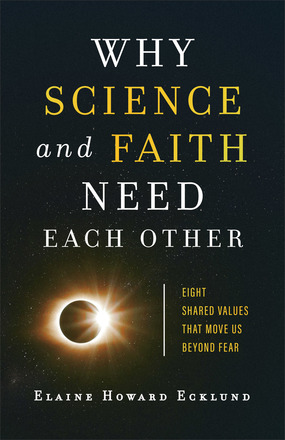Book review by D. Gareth Jones
Why Science and Faith Need Each Other: Eight Shared Values That Move Us Beyond Fear
By Elaine Howard Ecklund
Grand Rapids, Michigan: Brazos Press, 2020; 176 pages.
ISBN 9781587434365, 1st edition, paperback.
AUD$28
This book was slightly different from what I had expected. This is not a criticism of it, but a reflection of my own expectations as a scientist and ethicist. Ecklund is neither. She is a sociologist, who founded the Religion and Public Life Program at Rice University in the United States. She has a well-acknowledged reputation for her sociological studies on the relationship between science and faith, and in this book she seeks to make her results accessible to a general readership.
Throughout she inserts personal comments regarding the serious health issues she has had to face from an early age. Indeed, her sociological studies on the interaction of science and faith were prompted by these personal life experiences. This gives the text a flavour not generally found in books dealing with science and faith, since they give to her writings a practical edge rather than a theoretical one. Her use of these instances is wise and serves to bridge the science–faith divide at a number of significant points in the biomedical area.
Her understanding of the science–faith borderlands is secure, as she repeatedly delves into this territory. Her studies over many years have covered what religious believers think about science and what scientists think about religion. The scientists she has studied have been both Christians and nonreligious. Although Ecklund has interviewed individuals from many countries, the book is firmly set within an American context. This means that it reflects American evangelicals and the American evangelical scene. Hence, the views and attitudes are those of this subculture, especially when it comes to the responses of the rank-and-file within evangelical churches. While this does not detract from the validity of the conclusions Ecklund arrives at, there is no escape from the limits imposed by these horizons.
Over the years Ecklund has surveyed 41,000 religious believers and scientists on the relationship between religion and science. She has also conducted 1,290 in-depth, face-to-face interviews within this broad cross-section of individuals. Rather than overwhelming the reader with figures, she sparingly uses percentages. For example: 54% of Protestants see gene editing (to reduce the risk of serious diseases in babies) as meddling with nature, compared to 31% of those with no religious affiliation (p. 104; all figures are backed up by references). The way in which she brings these figures down to earth is by the use of quotes from individuals surveyed. The danger, of course, with this approach is that the author has to be very careful that they are representative of the major groups she is interested in, namely, church leaders, evangelical Christians in churches, evangelical scientists, and nonreligious scientists. As far as I can ascertain from my knowledge of science–faith debates, she is fair to these various groupings.
Ecklund never strays far from her central theme, namely, the way in which science interacts with religion, mainly evangelicalism. Of all the groups, the most problematic appears to be church leaders, depending upon the topic. This may be unfair on them since some of the topics require considerable expertise. But this is helpful since it highlights the limited degree to which Christians can realistically look to their minister for helpful direction in the science-faith area (with some notable exceptions). Ecklund considers that the input of Christian scientists in their congregations and communities is vital and should be utilised far more than is frequently the case. Ecklund makes these points eloquently in one area after another. From my own experience I have frequently lamented the pitiful degree to which scientists in churches are asked for advice, let alone listened to.
The book is divided most interestingly into what Ecklund describes as eight shared values, that is, values shared between science and faith. These are curiosity, doubt, humility, creativity, healing, awe, shalom, and gratitude. Under these headings, she discusses matters such as the fear of science in churches, doubt as a virtue in Christian communities, the place of humility in churches as well as in science, the importance of recognising creativity in medical areas such as infertility, the place of awe in science, and our limited appreciation of gratitude in all areas of our lives. There are many riches here, applying to the interactions between science and faith. By setting out virtues in this manner, Ecklund can probe into specifics and demonstrate surprising commonalities between the approaches of the scientist and the Christian believer.
There are few topics at the intersection of science and faith that are not touched upon. Readers will not be provided with the final word on any of these topics, but they will get an insight into the large number of similarities between scientific and religious values, and for most people this will come as a surprise.
It would be wonderful if this book were to be read by church ministers and others in leadership positions in churches, especially those sceptical of the legitimacy of science and those still thinking that the warfare between science and religion is alive and well. The ignorance of some churchgoers quoted in the book is horrifying. If the pervading ignorance in churches can be transformed and enlightened by this book, it will have served its purpose.

